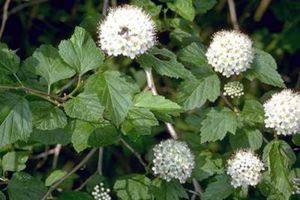Physocarpus
| Ninebark | |
|---|---|
 | |
| Genus: | Physocarpus |
| Family: | Rosaceae |
Physocarpus (Ninebark) is a genus of about ten species of flowering plants in the family Rosaceae, native to North America (most of the species) and northeastern Asia (one species).
Description
[edit | edit source]They are deciduous shrubs growing to 1-3 m tall. The name comes from the appearance of the bark, which is flaky, peeling away in many layers. The leaves are maple-like, palmately lobed, 3-15 cm long and broad, with an irregularly serrated margin. The flowers are white with five petals and numerous stamens, produced in corymbs. The fruit is a cluster of inflated follicles, which turn dry and brown and then split open to release the seeds.
Growing Conditions
[edit | edit source]Varieties
[edit | edit source]- Physocarpus alternans (Dwarf Ninebark)
- Physocarpus amurensis (Asian Ninebark)
- Physocarpus bracteatus
- Physocarpus capitatus (Pacific Ninebark)
- Physocarpus glabratus
- Physocarpus malvaceus (Mallow Ninebark)
- Physocarpus monogynus (Mountain Ninebark)
- Physocarpus opulifolius (Common Ninebark)
Uses
[edit | edit source]Current use of this plant in its name cultivars (see below) for landscape design is to form a line of uninterrupted, loose informal hedge. Individual specimens may be used for the attractive colors of the foliage. There are little medicinal or food uses of this plant.
Much development has gone into developing attractive foliage and smaller size of this native shrub. Two popular and common cultivars exist. 'Darts Gold' is a gold color leaf version of this native plant, while 'Diablo', a purple (almost black) leaf cultivar also exists.
Since the new century, much work is continuing to develop hybrids based on the above two cultivars. 'Coppertina' a cultivar exhibiting orange-red leaves, is such a development, created when the above two cultivars were crossed.
Maintenance
[edit | edit source]Little maintenance is required for this native shrub once established. To maintain the shape of the plant, pruning is highly recommended. As the old branches exhibit an exfoliating bark which is for some gardeners its chief attraction, leaving the older branches on the plant is often achieved by only pruning and rejuvenating one third of the older branches on a plant in any one year. If a more youthful looking plant is desired, then hard pruning of all the older branches may also be accomplished. In such a case, pruning should be conducted during the spring.
Propagation
[edit | edit source]Like all native shrubs that originate from a basal rosette of stems from a common root, this native North American shrub is easy to propagate.
The shrub after flowering forms many tiny seeds, which are held onto the plant well into winter. Mature seeds may be easily released when the shrub is brushed against or shaken. Seedlings formed from self seeding into cracks and crevices may be carefully removed and transplanted.
Another method of propagation is to divide the basal clump of stems, ensuring each group of stems are attached to a viable root. This is done by cleaving the clump at the basal rosette of stems, right down to the root level, separating the one clump into two or more smaller clumps. Each small clump can then be transplanted. In this initial stage, adequate watering is crucial to ensure the survival of the severed clumps. If a severed clump survives the first winter, it will live on. Severing of the clumps may be done anytime, but typically fall time is best, as the cooler temperatures and increased rainfall ensure less evaporation and demands on the smaller severed root system.
A third method is achieved by layering a long branch. This is done by bending one of the younger more flexible stems to the ground, and pinning it in place. Over the course of one year, tiny rootlets will develop where the stem touches the ground. At that point, the rooted portion may be severed from the mother plant and carefully tended.
Cuttings rooted in rooting hormone has a lower success rate but nonetheless may be a viable option of reproducing this species. However, many state laws prohibit the unauthorized reproduction of any named cultivar without the prior consent of the original nursery that had developed the cultivar.
Harvest
[edit | edit source]Pests and Diseases
[edit | edit source]References
[edit | edit source]
| Wikiversity is collecting bloom time data for Physocarpus on the Bloom Clock |
- Book:Horticulture/Finder/Types/Shrubs, Large
- Book:Horticulture/Finder/Conditions/Part Shade
- Book:Horticulture/Finder/Conditions/Full Sun
- Book:Horticulture/Finder/Special/Quality Nectar Source
- Book:Horticulture/Finder/Attractions/Butterflies
- Book:Horticulture/Finder/Resistance/Pests and Diseases
- Book:Horticulture/Finder/Attractions/Deer
- Book:Horticulture/Finder/Native/North America
- Book:Horticulture/Finder/Flowers/White